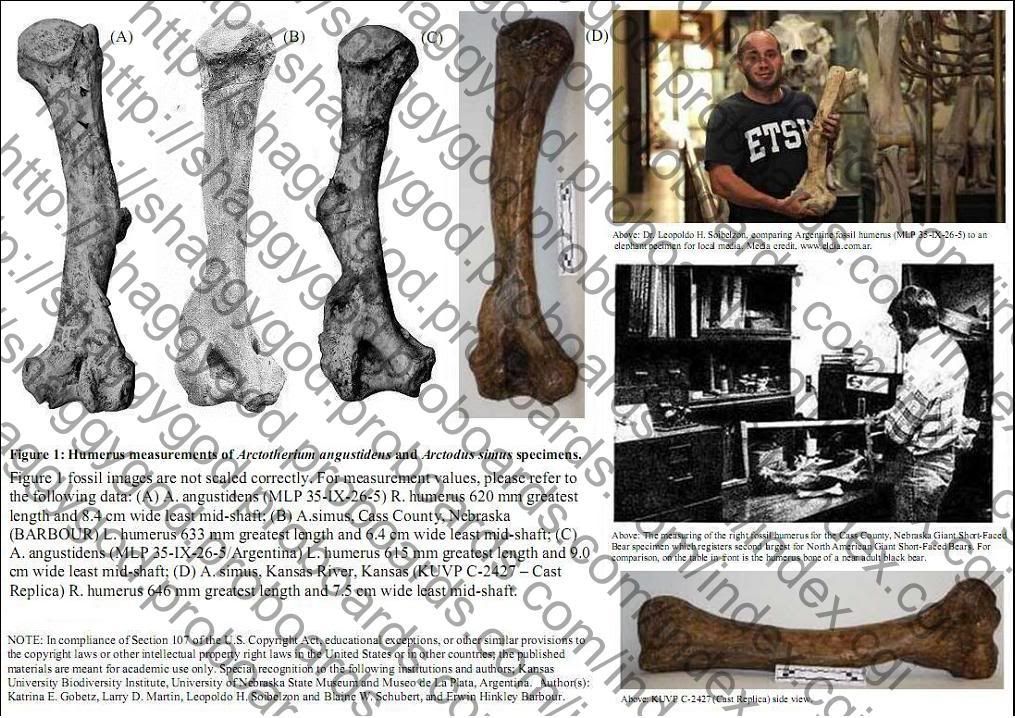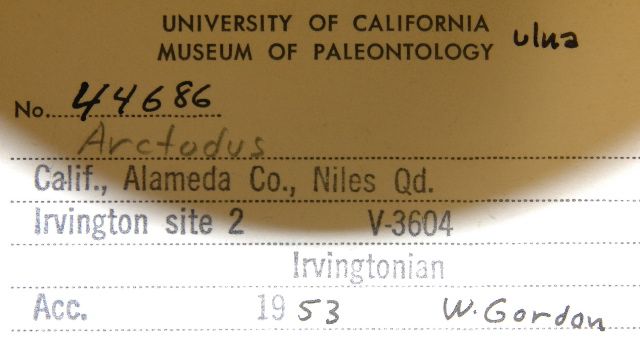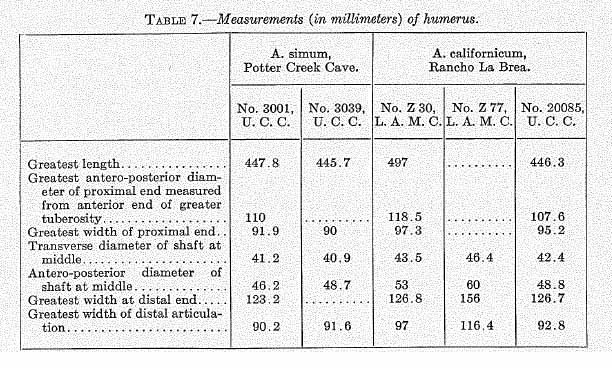|
|
Post by grrraaahhh on Jul 30, 2012 14:12:08 GMT -9
It seemed logical to combine topic relating older posts....Prehistoric AmericasGiant Short-Faced Bear: Arctotherium angustidens & Arctodus simus
|
|
|
|
Post by grrraaahhh on Jul 30, 2012 14:12:35 GMT -9
|
|
|
|
Post by grrraaahhh on Jul 30, 2012 14:13:08 GMT -9
Prehistoric EurasiaIs it true that the largest cave bear skull is 56 cm in length? I remember to have ridden in the book "The cave bear story" that Bjorn Kurten told that the biggest cave bear skull he had seen came from England... Warsaw had found relating information on the following two specimens: SKELETON OF A BEAR FOUND IN A CAVE IN STYRIA, AUSTRIA.The skull on the board is of especial interest on account of the beautiful crystals of calcareous spar, which are from 1/10 to 1/4 of an inch long, and are formed on the inner sides of the skull. The skull is 5-1/2 in. wide between the fangs and 6-3/5 in. wide at the forehead, whereas the skull of the skeleton is only 3-9/10 in. wide at the fangs and 5-1/10 in. wide at the forehead. The skull of the skeleton is 22 in. long. The small white object on the board supporting the detached skull represents the skull of an ordinary cat, thus giving an idea of the enormous size of the bear's skull. The skeleton is 9 ft. 8 in. high, and is one of the largest and most complete that has been found.  22 inch = 55.88 centimeter chestofbooks.com/crafts/scientific-american/sup4/Skeleton-Of-A-Bear-Found-In-A-Cave-In-Styria-Austria.htmland..... 56 cm skull discovered in a cave in Slovenia    I remember this story but for the life of me can not find the relating article link.
|
|
|
|
Post by warsaw on Jul 31, 2012 5:41:42 GMT -9
|
|
|
|
Post by grrraaahhh on Aug 1, 2012 14:43:27 GMT -9
Much appreciated follow up....thank you Warsaw.
|
|
|
|
Post by grrraaahhh on Aug 8, 2012 4:24:32 GMT -9
Who is paying attention and who is not:  Shhhhhhh......  |
|
|
|
Post by grrraaahhh on Aug 15, 2012 6:58:13 GMT -9
It seemed logical to combine topic relating older posts....Prehistoric AmericasGiant Short-Faced Bear: Arctotherium angustidens & Arctodus simus In examining the largest GSFB humerus fossil (A.angustidens), it is difficult to quantify the full impact of the large pathology at the mid shaft point; compare both left and right fossil humerus measurement values for the South American giant. |
|
|
|
Post by Ursus arctos on Aug 15, 2012 8:58:00 GMT -9
In examining the largest GSFB humerus fossil (A.angustidens), it is difficult to quantify the full impact of the large pathology at the mid shaft point; compare both left and right fossil humerus measurement values for the South American giant. The article followed Merriam and Stock (1925) for measurements. I haven't read that article, but if the midshaft measurements included these pathologies (note that the left humerus was wider; 9.3 vs 9.1 cm in AP diameter, and 9.0 vs 8.4 cm in ML diameter) they may exaggerate the size of this animal, especially in comparison to these largest Arctodus simus specimens with even longer humeri. At regions other than midshaft (where the pathologies are) the widths look similar. And I don't only mean the epicondyles-the actual diaphysis look similar in shape and width elsewhere. Arctotherium angustidens was probably much larger on average as a species or even regional population (hard to say when sample size of mature males=1), but I wouldn't be surprised if the largest known individual bears so far are all actually Arctodus simus. |
|
|
|
Post by grrraaahhh on Aug 15, 2012 17:55:34 GMT -9
In examining the largest GSFB humerus fossil (A.angustidens), it is difficult to quantify the full impact of the large pathology at the mid shaft point; compare both left and right fossil humerus measurement values for the South American giant. The article followed Merriam and Stock (1925) for measurements. I haven't read that article, but if the midshaft measurements included these pathologies (note that the left humerus was wider; 9.3 vs 9.1 cm in AP diameter, and 9.0 vs 8.4 cm in ML diameter) they may exaggerate the size of this animal, especially in comparison to these largest Arctodus simus specimens with even longer humeri. At regions other than midshaft (where the pathologies are) the widths look similar. And I don't only mean the epicondyles-the actual diaphysis look similar in shape and width elsewhere. Arctotherium angustidens was probably much larger on average as a species or even regional population (hard to say when sample size of mature males=1), but I wouldn't be surprised if the largest known individual bears so far are all actually Arctodus simus.  Source: Source: Merriam & Stock (1925). Give me a little time but there are a handful of high profile fossil-heavy articles (Barbour, Gobetz, Kurten, Richardson) that I want to double check again regarding humerus measurement. Warsaw can attest, the pathology problem drove me nuts. Any photo and video of the fossils were scrutinized. I found little consensus about its impact. Regrettably, the fossil record for mature male GSFB fossils is limited. Nonetheless, I remain hopeful. I think paleontology as a discipline is improving/growing; more researchers, better funding, volunteer increases, and hopefully better field/equipment improvements. In this context, it would not surprise me if additional large (mature) GSFB specimens in both North & South America (I'm sure we can do better than one 'mature' specimen) were discovered. |
|
|
|
Post by grrraaahhh on Aug 17, 2012 10:37:56 GMT -9
I figured there would be interest in the remaining North American GSFB humerus measurement values:
Kansas River, KS, KUVP C-2427, Humerus (mm)
Total length: 646
Greatest ant./postr. prox. width: 134
Least transv. width: 75
Least ant./postr. shaft width: 68
Average width shaft: 71.5
Greatest transv. width distal end: 185
Ant./postr. caput diameter: 114
Source: Gobetz, K.G., Martin, L.D., 2001.
Cass County, NE (Barbour) Humerus (mm)
Total length: 633
Anteroposterior diameter of head: 115
Tranverse diameter of head: 110
Greatest diameter of proximal end: 158
Least anteroposterior diameter of shaft: 75
Least transverse diameter of shaft: 64
Average diameter of shaft: 80
Transverse diameter through condyles: 180 *
Transverse diameter through trochlear surface: 130
Anteroposterior diameter, trochlear, radial side: 55
Anteroposterior diameter, trochlear, ulnar side: 65
Anteroposterior diameter, trochlear, middle: 44
Bone lamina between coronoid and anconeal fossae: 11
Extreme depth anconeal pit: 65
Diameter, entepicondylar foramen, approximately: 19
*Greatest distal width across epicondyles: 178 (Kurten, 1967).
Source: Barbour, E.H. 1916; Kurten, B. 1967.
If there is interest, there are author notes relating to the fossils. I can provide them as follow up material.
also.....
Follow up to the Merriam & Stock/CA specimens:
"Cox (1991) and Scott and Cox (1993) showed that some large specimens were present at Rancho La Brea, but that the measurable sample is skewed towards females (the majority of adult specimens) and adolescent males, where long-bone epiphyses were not fused (S. Cox, pers. comm. to Richards, 26 July 1989; Agenbroad and Mead, 1986; Cox, 1991; Scott and Cox, 1993)."
Richards et al. (1996).
Note: Correction, in my previous post I referenced one author as Richardson, I meant Richards, L. Ronald (see above quote).
|
|
|
|
Post by grrraaahhh on Aug 17, 2012 10:44:26 GMT -9
All, if you have access to European university materials (preferably the top schools) and are interested prehistoric bears (especially cave bears) your help and time to obtain similar data for discussion and examination (like we do here) is welcomed and appreciated.
~ Grrraaahhh
|
|
|
|
Post by Ursus arctos on Aug 17, 2012 13:33:49 GMT -9
I have very limited access at the moment. Considering large samples of Ursus spelaeus, there are hopefully also some exceptionally massive specimens of that species. Anyway, quoting "THE LARGEST KNOWN BEAR, ARCTOTHERIUM ANGUSTIDENS, FROM THE EARLY PLEISTOCENE PAMPEAN REGION OF ARGENTINA: WITH A DISCUSSION OF SIZE AND DIET TRENDS IN BEARS" by Soibelzon and Schubert:  vs Kansas River, KS, KUVP C-2427, Humerus (mm): Arctotherium has greater proximal AP diameter, but similar distal breadth. Quick question: is transverse diameter really less than anteroposterior diameter of that A. simus specimen? vs Cass County, NE (Barbour) Humerus (mm): A. simus has greater proximal diamters, similar width of the distal ends (slightly greater in Arctotherium). Among cats and canids the humeral epicondylar index (humeral epicondylar ML breadth/humerus length) and humeral robusticity index (humerus ml diameter/humerus length) are correlated. Would take some work (more than my old laptop can do) to actually calculate the correlation coefficient. I do not think it is likely that there was any significant difference in robusticity between Arctotherium angustidens and Arctodus simus. Any info on ulna or radii? You posted some here, where the largest Arctodus simus again exceeded Arctotherium angustidens in length. Now, I really hope that more mature male Arctotherium angustidens specimens are found (I hope you're right about that). Would be amazing to discover more such massive bones; with a larger sample some may exceed even these A. simus specimens in size. |
|
|
|
Post by ursidae on Aug 17, 2012 15:17:37 GMT -9
Hello, your forum is very good because of very interesting data about bears. Unfortunately your data are not very well displayed, but i don't blame you, i understand this requires a lot of work to organize a lot of data. Concerning the largest bear fossils it would be interesting to speak about others bear species like cave bear, agriotherium, and indarctos. We know that all these species generated very large specimens but it seems more difficult to find measurements about them...Do you have any measurements about humerus, ulna...for these three taxons? Is there any scientific publication about the large cave bear skulls you evoked? (56 cm and 55,88cm) It is also unfortunate we don't have any measurements about the humerus of the specimen UVP015 (arctodus), we could have made body mass estimations of KUVP C-24-27 as we have a body mass estimation of UVP015... Here is a photo of a large arctodus simus skeleton:  |
|
|
|
Post by grrraaahhh on Aug 18, 2012 5:07:20 GMT -9
I need a little time to properly inventory the GSFB fossil specimen data (some of which have already been posted in other threads) which I will post soon. It might help some people to become familiar with some of the notable GSFB 'mature' specimens: Ivringtonian, Alameda County, CA. Lake Bonville, UT. Hays Spring, NE. Cass County, NE. Kansas River, KS.  The Hay Springs GSFB is one of the notable larger North American specimens obtained.  Lake Bonneville, Utah (Kearns pit) Giant Short Faced Bear fossil femur display. Measuring at 720 mm greatest length, the Utah femur fossil is the longest GSFB sample obtained. www.flickr.com/photos/bryanto/4248696802/in/photostream/RE: cave bear, agriotherium, and indarctos published materials and assistance, IMO, they are not as organized as their GSFB counterparts. In the example of the cave bear, there is a lot of material written but I think we are interested in mature specimen info (me personally, the interest is with limb bone fossils). Also, a lot of the key 'older' materials are written in French, German, Spanish, etc. which is why I am always encouraging international forum activity and assistance. While the US has excellent research capacity, certain international materials (university, museum, & technical data) are harder to access from the states. Nonetheless, I will review and post what information I have. Regarding 56 cm and 55,88 cm specimen, another review of the literature is necessary. Off the top of my head, I am not sure what if anything "professionally" been written about them. More to come... |
|
|
|
Post by ursidae on Aug 18, 2012 8:00:51 GMT -9
The short faced bear UVP015 is estimated to have weighted 957 kg, but : does this value include a high percentage of fat like brown bear before hibernation?
In other words: did arctodus hibernate?
|
|